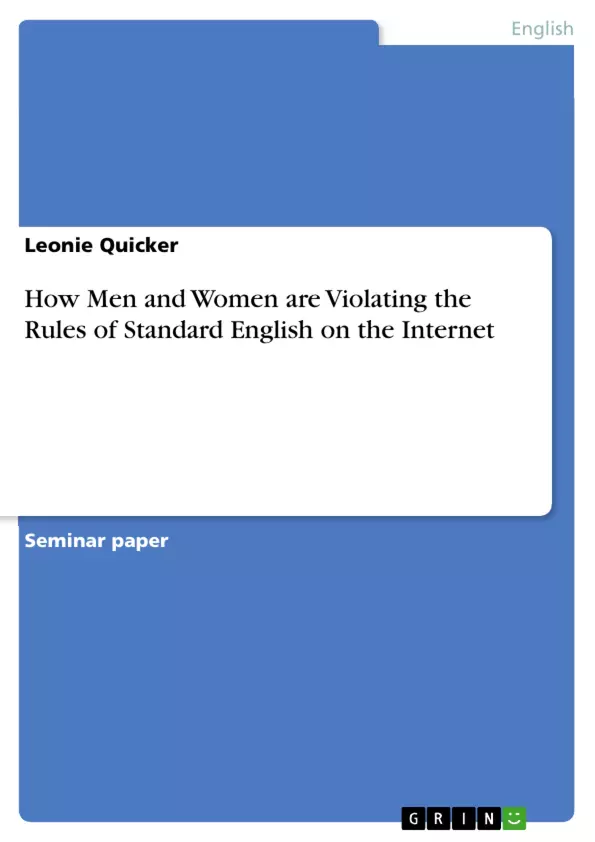This study was set out to investigate if gender influences the usage of Standard English on the internet.
"What r u doing 2day? :)" "I do not know. Do you want to watch a movie with me?" It is not difficult to identify both sentences as examples of the English language; nevertheless, upon taking a closer look a few differences are still noticeable. English is ranking the second place of the most spoken languages in the world and is known to be widely spread due several reasons, like globalisation and thereby spreading communication around the world. However, there are many different situations in which English can be used for and different degrees to how well it might be spoken. For instance, the English variety used on the internet in blogs or on other websites, might vary from the English that is used in the news and official documents and might as well contain slang words or grammatical mistakes. Therefore, it is divided into a form of Standard English and Non-Standard English.
One of these factors that may influence the correctness of the English language is the aforementioned internet. The internet usage has increased in the last two decades and leads to people communicating with each other from different places, most of the times with English as the main language. In order to communicate as quickly as possible, as well as accurate as possible, certain patterns have been established throughout the years, such as abbreviations or emoticons, like they were used in the first example.
Since previous research has shown that women tend to pay more attention to the correctness of their language than men do, this term paper is set out to investigate if there are indeed distinctions between men and women concerning Standard and Non-Standard English, based on communications on the internet. Does gender play a decisive role in influencing the use of grammatical correctness on the internet? In order to gather information and data, this research project has asked a number of native English speaking people to respond to short instant messages. This procedure and its results however, will be further explained in the following chapters.
Inhaltsverzeichnis (Table of Contents)
- Introduction
- Definition of Standard English
- Previous Research
- Methodology
- Analysing Results
- Standard and Non-Standard English
- Punctuation
- Use of Capital and small initial letters
- Abbreviations
- Emoticons
- Errors and grammatical Incorrectness
- Further Observations
- Discussion
- Conclusion
Zielsetzung und Themenschwerpunkte (Objectives and Key Themes)
This research aims to investigate if there are discernible differences between men and women in their use of Standard and Non-Standard English on the internet. It explores whether gender plays a significant role in influencing the grammatical correctness of online communication. To achieve this, the research project analyzes data collected from native English speakers responding to short instant messages.
- The relationship between gender and the use of Standard and Non-Standard English in online communication.
- The impact of the internet on language usage and the emergence of unique features in online communication.
- The definition and importance of Standard English and its role in online contexts.
- Previous research on internet language and the influence of social context on communication patterns.
- The specific grammatical and orthographical features that characterize online language, such as punctuation, abbreviations, and emoticons.
Zusammenfassung der Kapitel (Chapter Summaries)
- The introduction introduces the topic by examining the differences in English language usage on the internet, specifically focusing on Standard and Non-Standard English. The research project's aim is to investigate potential gender-based variations in language use on the internet.
- Chapter 1 defines Standard English by explaining the process of language standardization and how social status and power influence language varieties. It highlights the importance of Standard English as a formal language used in various contexts.
- Chapter 2 reviews existing research on internet language, focusing on studies like Derks et al. (2007), which investigated the use of emoticons in social contexts. This chapter emphasizes the unique features of online communication and the impact of social context on language choice.
Schlüsselwörter (Keywords)
This research focuses on the study of Standard and Non-Standard English in online communication, specifically investigating the influence of gender on language use. Key themes include internet language, grammatical correctness, emoticons, abbreviations, and social context. The project draws upon existing research on internet language and utilizes a methodology involving analyzing data from native English speakers' responses to short instant messages.
- Quote paper
- Leonie Quicker (Author), 2018, How Men and Women are Violating the Rules of Standard English on the Internet, Munich, GRIN Verlag, https://www.grin.com/document/1367022



